Jacobsdal, just 154 kilometres west of Bloemfontein, is where the first wine cellar outside the Western Cape was built. Ondela Mlandu went there to taste the wines of the platteland. Photographs by Teagan Cunniffe
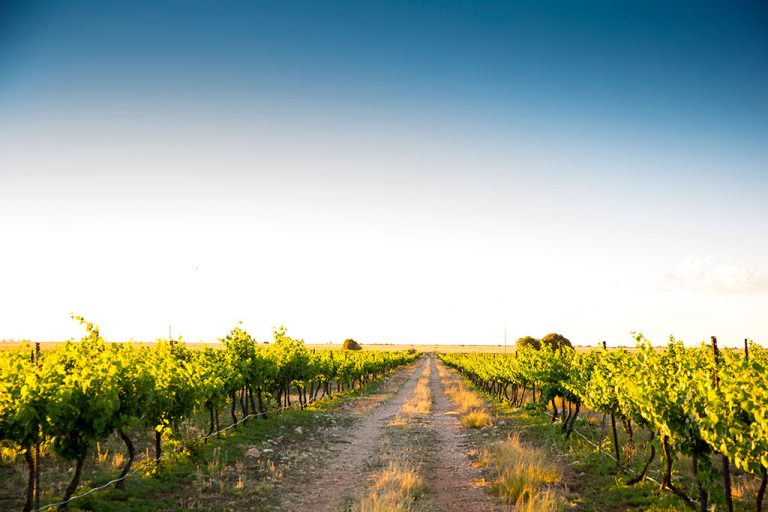
The sun sets on vineyards at Botebo Farm in the western Free State. Image by Teagan Cunniffe
The insider
Farmer and businesswoman Tebogo Ditsebe has spent the past seven years growing grapes in Jacobsdal using eco-friendly practices. She has dreams of making the Free State winelands come alive.
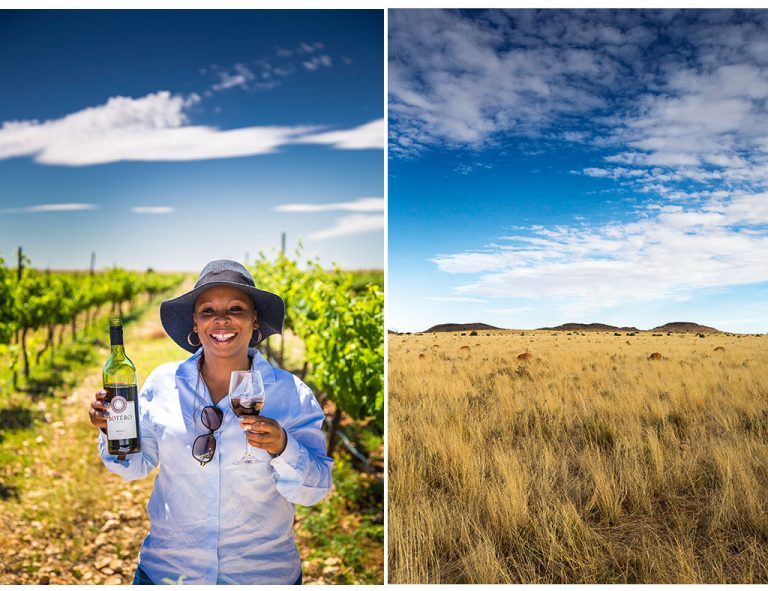
Tebogo with a bottle of her Botebo wine; vast grasslands at Botebo. Image by Teagan Cunniffe
What do the Brits, Boers and wine have in common? Along the R705, just 15 kilometres from the Free State-Northern Cape border, is Jacobsdal – an agricultural community surrounded by lush farmland irrigated by the four major rivers that converge nearby: the Orange, Vaal, Riet and Modder. Jacobsdal was the first town in the then Orange Free State to come under British rule in 1859, and where much blood was shed during the Anglo-Boer War of 1899 – 1902.
My biggest concern, heading there, is that this could be a typical one-horse town with very little to see or do. There’s a Spar on the right-hand side of the main street, a butchery and a couple of ATMs. What had brought me here in the first place? Encountering Tebogo Ditsebe in June last year at the Cape Town Good Food and Wine Show. A wine farmer from the Free State? That was intriguing enough. I let out a sigh of relief – there is a bit of life here. The town is flat and simple, with houses that have well-maintained gardens. There is a beautiful church in the centre dating from 1879. With a population of about 8000, an outsider is easily spotted – and a source of curiosity. ‘What are you doing here?’ they always ask.
Soon Teagan and I are in Tebogo’s bakkie, driving through the beautiful vineyards on her farm, Botebo, a couple of kilometres from town. Botebo means ‘depth’ and she explains: ‘The soil in the Free State is rich and deep, making it suitable for all kinds of farming. This fertile soil produces grapes of quality.’ Originally from Kimberley, Tebogo has spent seven years in Jacobsdal tilling her land. A friend of hers from Holland suggested she venture into wine farming. She initially had floriculture in mind but while she was waiting for her farming licence to be approved, which took two years, she went to Cape Town and learnt all she could about winemaking.
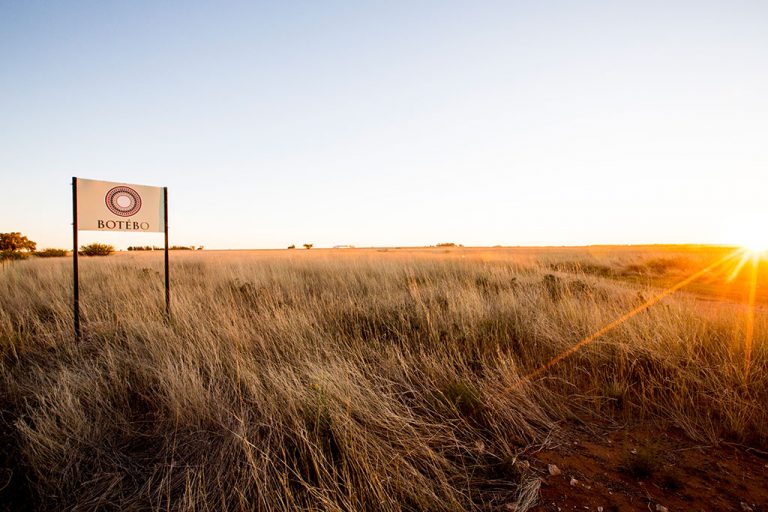
The sunset stroking the grasslands of Botebo Farm. Image by Teagan Cunniffe
‘When I found this place, it never looked this way. What my friend failed to tell me was the trial and error that goes into owning a wine farm,’ she says. ‘But my first harvest was a bumper crop.’ When she first moved to Jacobsdal she had no farm tools. ‘One of the farmers who let me borrow his tools seven years ago recently reminded me that I never gave them back!’ she laughs. ‘I know people think Jacobsdal is uneventful, but I have a soft spot for this place. The heart of Jacobsdal is the people.’
Tebogo takes us to the farm’s water supply, which comes from the Riet River canal system, which in turn is fed by the Vaal River and also provides water to other farms in the area. The outskirts of Jacobsdal are different shades of green, with darling big-eyed cows mooching around. We are back on the R705, heading out of town to the Môredou Padstal. It’s Tebogo’s favourite place to eat and we’re going to have lunch with the owner, Odrie Holtzhausen. Odrie was instrumental in making Tebogo’s early days in Jacobsdal a bit easier, as she would do her work at Môredou before her farm had working offices. The two women formed a lasting friendship.
After a divine chicken burger and soaking up the local atmosphere, we drive back to town to Landzicht Wines. It’s here that the first vineyard was planted in the Free State in 1950. We meet the neighbour, Aretha van Rooyen, who happens to be visiting when we arrive and gives us a taste of all the wines (my favourite was the Chenin). She tells us the farm’s history, proudly showing off the awards it has won over the years, as if it’s her own farm. ‘We are all family here,’ she says. It’s a sentiment echoed over and over again by other people we meet. The people of Jacobsdal are breaking down boundaries. There is a wonderful rapport between locals, and women like Tebogo and Odrie are being encouraged and supported in their business ventures. Everyone is keen on working together to encourage tourism.
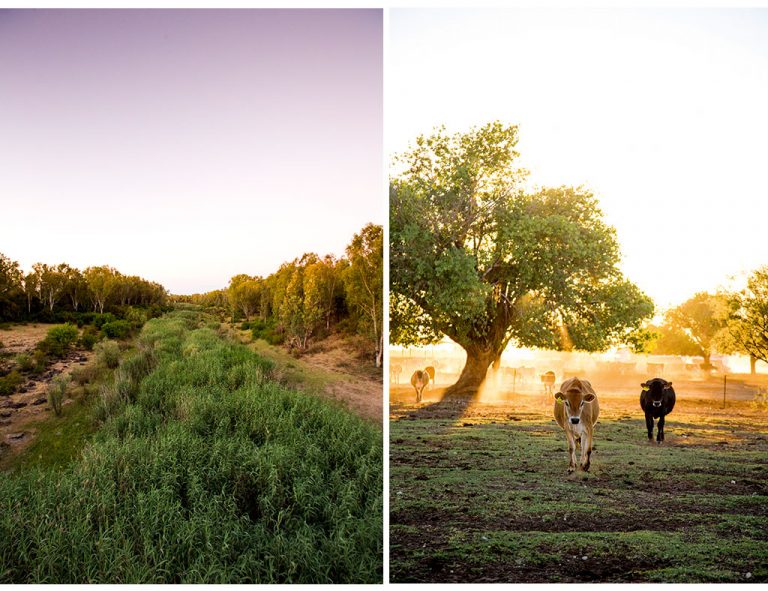
Next to the Riet River is a braai and potjie spot; inhabitants of Dorie Dorings dairy farm. Image by Teagan Cunniffe
That night, Teagan and I venture out for dinner at the Vlakvark Pub & Grill, which had been highly recommended by the locals. We arrive to find a large group of bikers who have stopped over en route to Bloemfontein for a quick bite. Barbie and Kev Ellison, originally from Prince Albert, welcome us warmly and share stories of their travels and how rewarding managing the Vlakvark has been. Listening to them talk, I think about that long-ago war between the English and the Boers, and the animosity it must have created in the generations that followed.
Times have changed here and there’s a palpable generosity of spirit. The English Ellisons are affectionately called oom and tannie in town. ‘This is a farming community and I think we’re doing really well,’ says Barbie. ‘I imagine Jacobsdal becoming a place where city folk visit to get away from the rush. Our little Jacobsdal will make a wonderful getaway’.
3 historical finds along the way
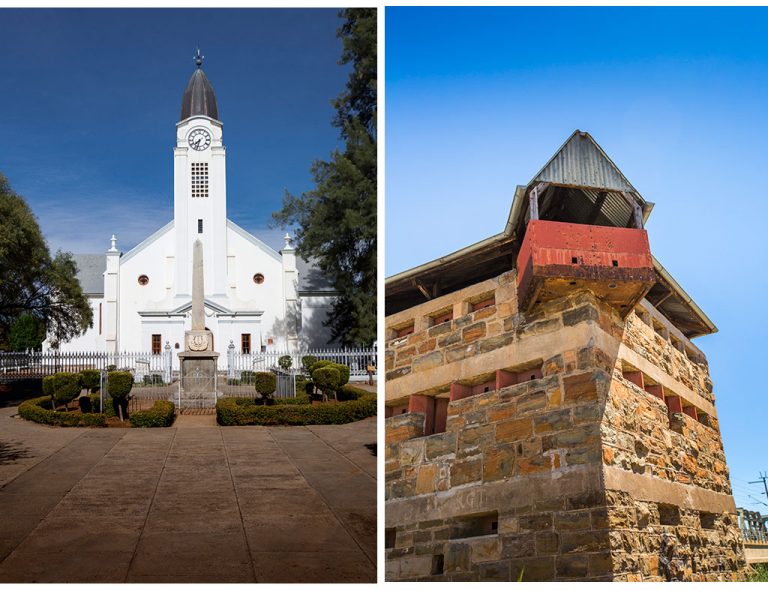
Jacobsdal NG Kerk was one of the first in the Free State; the British Block House joins two provinces. Images by Teagan Cunniffe
1. NG Kerk
The church in Jacobsdal was used as a hospital during the Anglo-Boer War by the British, so services and baptisms had to be conducted elsewhere. It was built in 1879 and enlarged in 1930. It has a bullet hole in its front door.
2. Anglo-Boer War Graves
Jacobsdal’s original cemetery has tombstone engravings dating back to 1859, and most belong to British soldiers buried here during the war. Find it in De Villiers Street in the centre of town.
3. British Block House
This three-tiered stone fort was built in 1900 to guard the railway bridge that connects the Free State and Northern Cape. It’s easily accessible by tar road (the R705)
Where do the locals go?
Barbie Ellison, restaurant manager
‘Rietpan Nursery, along the Modder River, grows delicious pecan nuts.’ Visits and purchases by appointment. 0835020781
Kempen Nel, farmer
‘The Magersfontein Memorial Golf Estate is close to the Northern Cape border. It’s fun to putt a few holes.’ 0833998668
Felicity Metsimetsi, waitress
‘I enjoy going to the Riet River to relax with friends over a lovely potjie or a braai right next to the river.’
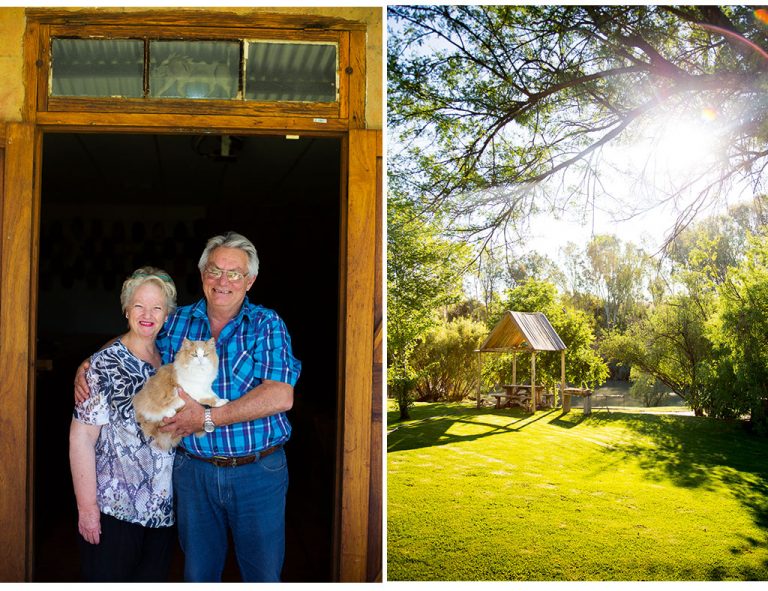
Restaurant managers at The Vlarkvark Pub and Grill–Barbie and Kev Ellison; Bass Paradise Fishing and Holiday Resort on the banks of the Riet River lives up to its name. Image by Teagan Cunniffe
Plan your trip
Getting there
We flew from Cape Town to Bloemfontein with Mango for R2 078 return. Once you exit the airport, follow the N8 for about two hours to get to Jacobsdal. Locals told us that the quickest way to get to Jacobsdal is to fly to Kimberley from Joburg (from R2018 return on Mango) and take the N12 to Jacobsdal (55 minutes). See more on Travelstart
Stay here
Bietjie Moeg is a self-catering farmhouse close to the centre of town, with four en-suite rooms, a well-equipped kitchenette and a braai on the patio. R600 a night for two.
Du’ Villa Bed and Breakfast has three individually decorated en-suite rooms, each with its own private entrance from the tranquil garden, which has a lapa. The rooms come with DStv, air-con, a microwave and bar fridge. From R350 per person sharing.
Do this
Try the local wine at Landzicht. Its noteworthy award-winning wines include the Chenin Blanc, Reserve Merlot and port. Tastings are free. 0535910164
Buy some Shalom Olives. Hannelie Kaplan makes them at home and everyone loves them, including her rottweiler! Flavours include rosemary and garlic, and oregano with black pepper. R55 a bottle. 0840150992
Enjoy the Riet River. You can swim, but look out for the catfish. Water from the Orange River flows under the low bridge. The river is accessed from Vinger Street.
Go fishing in the Riet River at Bass Paradise Fishing and Holiday Resort (catch and release). R50 adults, R25 children. Boats and fishing equipment can be rented. 0823068511
Visit Drie Dorings dairy farm. It produces unpasteurised butter with minimal salt added. Phone ahead to visit. 0823718143. The butter is also sold at the butchery in Jacobsdal. 0535910059
Splurge at Die Pershuis. This is Jacobsdal’s ‘shopping centre’ – you’ll find a printing company, a gym, locally made clothing and a hairdresser, along with other shops. It’s in Andries Pretorius Street.
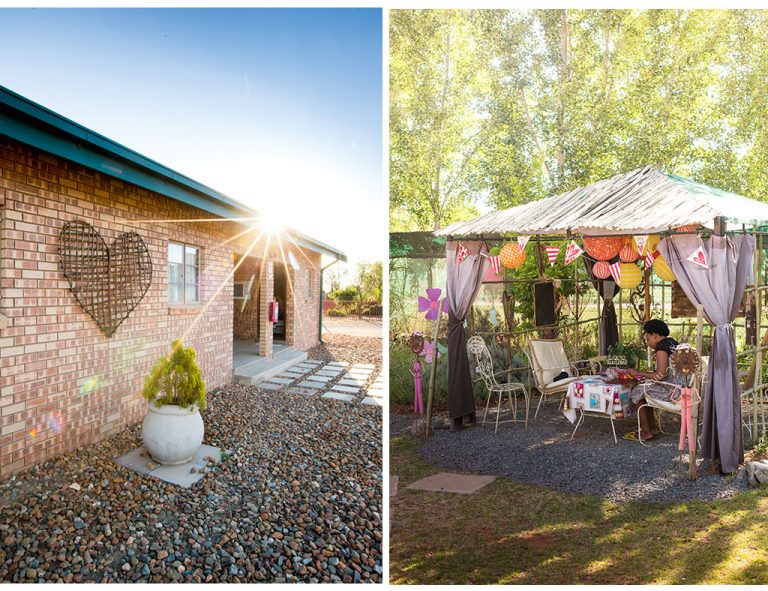
Self-catering farmhouse Bietjie Moeg; Blikaspaai Restaurant is a wonderful spot and, with its playground, suitable for the whole family. Image by Teagan Cunniffe
Eat here
Môredou Padstal is about three kilometres from town on the R705. There are daily specials (R45 for toasted bacon, egg and cheese with chips). There’s also a gift shop to pick up souvenirs. 0732314757
Vlakvark Pub & Grill, about seven kilometres from town on the R705, was a hospital before it became a restaurant in 1982. The food is tasty and portions are generous. Farm-style breakfasts, lunch and dinner are served. A delicious rack of spare ribs costs R90, drinks start at R12. 0818480232
Blikaspaai Restaurant has delightful decor – all pink and playful. It makes excellent cappuccinos with cream, and delicious breakfast pitas from R60. 0833957410
Deli Koffie Huis is part of Die Pershuis. Large milkshakes are only R20. It also serves light lunches – try the beef lasagne and salad for R55. 0781662949
Picnic or braai at Landzicht Wines Lapa. The estate allows the public to use the picnic and braai area for free (local high-school kids have their valedictory celebrations here). 0535910164
This expert advice first appeared in the January 2018 issue of Getaway magazine.
Get this issue →
Our bucket list January issue features 48 fabulous destinations to suit your budget, time frame and wildest fantasies. Here’s why you should go to Botswana, Namibia, Malawi, Mauritius, Mozambique, Zambia and Hawaii in 2018.
You may also like
Related Posts
The Northern Cape landscape and its characters are full of life. Here are some of...
read more
If you're feeling a bit tired of the usual scene, take a tip from urban...
read more
The east coast is our very own tropical paradise with warm waters and laid-back vibes....
read more